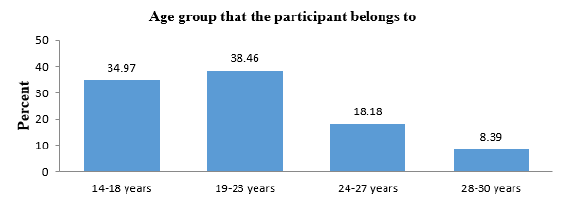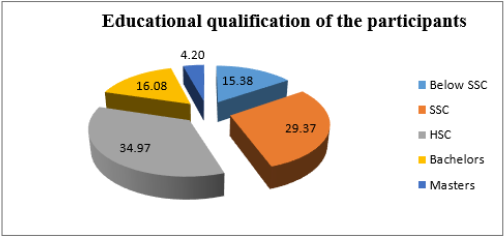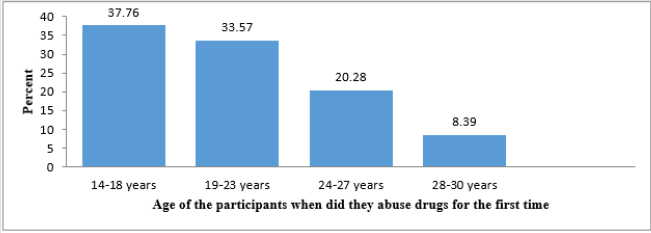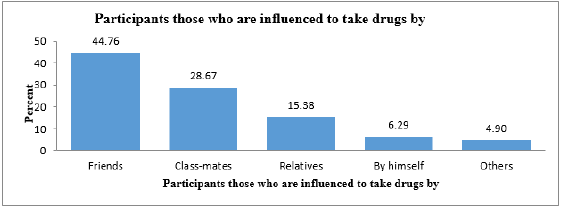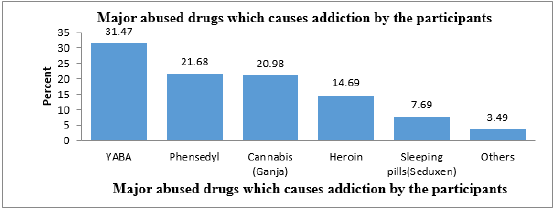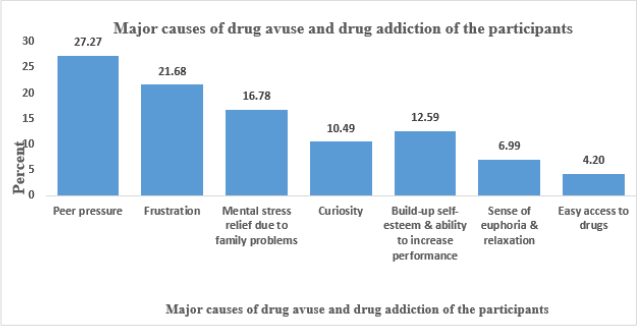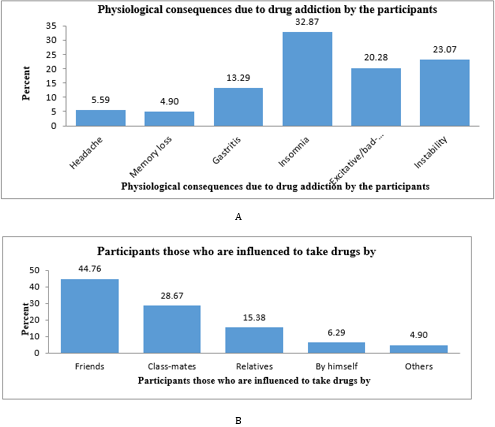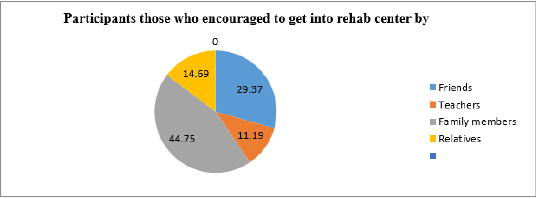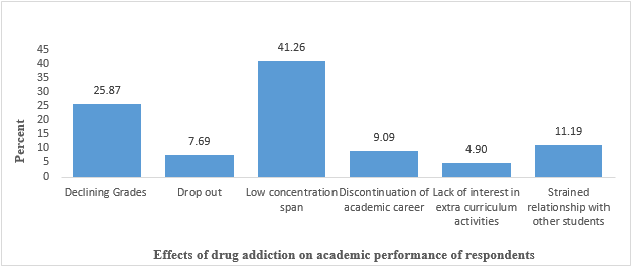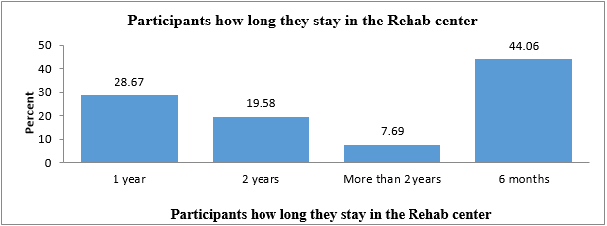Abstract
Drug abuse and addiction also called substance or chemical abuse, is a disorder that is characterized by a destructive pattern of applying drugs thereby leading to significant problems or distress. This phenomenon cuts across every strata of human society but more dominant (37.76%) among the youths (14-18 years). The study, analytical research design, and simple random sampling have been followed also explores data from both primary and secondary sources. The present findings suggest that Yaba (31.47%) was major abused drugs in the age between 14-30 years. (31.47%). The findings on the extent to which several factors influence students to abuse drugs such as mostly peer pressure (27.27%, frustration, mental stress relief, curiosity, buildup self-esteem & ability to increase performance, sense of euphoria. Most of the drug addicts think that peer pressure and frustration are major cause of drug addiction. Due to drug addiction many physiological consequences have been faced by the student’s likely headache, memory loss, gastritis, highest was insomnia (32.87%), bad tempered and instability. Drug addiction effected on academic performance resulted severe grade decades, drop out, low concentration span (41.26%), discontinuation of academic career, lack of interest in extra curriculum activities and strained relationship with other students. So the research concludes and recommends that parents and public enlighten should be carried out periodically on the dangers of drug addiction. While the regulatory bodies be strengthened to carry out their functions.
Keywords: Drug Addiction; Abuse; Students; Academic Performance
Introduction
Drugs are substances that influence the physical and mental
state of persons essentially and destructively any substance that
can prompt compulsion, abuse and reliance is a medication [1].
The level of enslavement for drugs increments with every day of
utilization. On the off chance that drugs are not accessible, the
patient shows discriminating withdrawal manifestations when
prompt restorative consideration is expected to forestall physical
and mental decay, even demise (Psychology) [2]. World Health
Organization (WHO 2002 and 2003) characterizes tranquilize
as a compound substance planned for indicative, restorative or
palliative utilization or for altering physiological elements of
man and creature, [south_Asia_Regional_Profile_Sept_2005/08_
bangladesh.pdf]. Opium has been used for medical purposes since
3500 years ago. Morphine was discovered in 1806 and codeine
in 1832. Cocaine was extracted from leaves of coca plant in 1860. Injecting morphine and heroin was expanded at the beginning
of 20th century [3-5]. Addiction to drugs is one of the saddest
tragedies of modern man which threatens his life. Despite this,
unfortunately tendency toward these deadly substances, especially
opiate substances, is daily increasing, especially among adolescents
[6]. Drug consumption in Iran has started thousands of years ago.
Over the last century, expanded consumption of heroin and other
narcotics, especially ecstasy and cocaine during past decades has
complicated the condition of drug abuse in our country [3,7-10].
Studies conducted by United Nations show that more than
180,000,000 people in the world are addicted to drugs [11-14].
On the other hand, quitting addiction is complicated and difficult
and is not successful most of the times [15]. Hashish is the most
prevalent drug being used in America and many other countries.
In North America, south and center of America most problems
occur due to consumption of cocaine [16]. Most used drugs in
Europe are cannabis, heroin, amphetamine and hallucinatory,
besides to ecstasy. In most Asian countries most problematic
drugs are cannabis and opiate substances [17,18]. According to a
United Nations Office on Drugs and Crime (UNODC) Report (2005),
about 200 million people, or 5 percent of the world’s population
age between 15 and 65 have used drugs at least once in the last
12 months. Likewise, according to the World Drug (2005) reported
that, the use of illicit drugs in all Nations has increased in recent
years. For most of Europe and Asia, opiates accounted for 62 percent
of all drug treatment sought in 2003. A survey in the Czech Republic
showed that 37% of new drug users were teenagers between 15
and 19 years old. In Egypt, drug use - in particular heroin use - is
becoming a serious problem and nearly 6 percent of secondary and
tertiary school students admit to having experimented with drugs
[15]. The history of human race has also been the history of drug
abuse [19]. History tells us that the Chinese used Opium as a cure
of dysentery before the 18th century. European countries such as
Britain and Holland were known to exchange opium growth in their
colonies for tea and silk with China [20].
State of Drug Abuse and Drug Addiction Global Perspective
Drug abuse is a global problem that poses a great danger to the lives of individuals, society and political stability and security in many countries [United Nations 1995]. According to the United Nations (2005), the use of illicit drugs has increased throughout the world and the major world trend is the increasing availability of many kinds of drugs among ever widening spectrum of consumers [21-23]. A study carried out by the London School of Economics in 1980, on students learning behavior revealed a relationship between drug abuse addiction and poor academic results [Otieno et al. 1994]. The continent, over recent years has experienced an upsurge in the production, distribution and consumption of drugs with the youth and young adults being most affected [24-26]. In Ethiopia, it is reported that 82 per cent of the street children in Addis Ababa use some kind of a drug [27-29]. According to the United Nations (UN) statistics (2013), 37,000 people in Africa die annually from diseases associated with drug abuse.
State of Drug Abuse and Drug Addiction: Bangladesh Perspective
Adolescents, especially those who are socially weak, may choose drug abuse as a means to integrate themselves into a peer group, and thereby increase self-esteem and decrease anxiety [30]. They feel failure and frustrated. Parental factors exert significant influence on the overall development of the child. It is not only impairing public health, but also corrupting institutions, retarding socio-economic development, and threatening political stability and, in some cases, impacting state security [31-33]. Due to drug addiction, criminal activities are increasing with alarming rate in all over the country. Especially in urban areas like Dhaka, Chittagong, Rajshahi, Khulna, Barisal and Sylhet. According to Family Health International (FHI) about 50 lac people of Bangladesh are drug addicted [34].
Materials and Methods
The present study designed as descriptive, qualitative and cross-sectional type, conducted in various Rehabilitation centers located in Dhaka city. The study population was consist of students in Rehabilitation center aged 14 to 30 years old. Random sampling technique (Probability sampling) was applied for determining sample size and data collection. Data was collected by a self-administered questionnaire, which was pre-tested. The investigation was conducted upon 143 students in various rehab center located in the Dhaka city located in the Dhaka city. The questionnaire and findings are based on the objectives and variables. Data was processed and analyzed using Microsoft Excel and SPSS version 21.00.
Ethical Considerations
Approval letter for conducting research was taken from American International University- Bangladesh (AIUB) during MPH courses
Results and Findings
In the present study, 34.97 percent of the participants were 14-18 year olds, 38.46 percent of the participants were 19-23 year olds, 18.18 percent were 24-27 year olds and 8.39 percent were 28-30 year olds (Figure 1), 79.72 percent of the participants were males, and 20.28 percent of the participants were females. Showed that 15.38 percent of the participants were below SSC, 29.37 percent passed SSC, 34.97 percent passed HSC, 16.08 percent passed bachelors and 4.20 percent passed masters (Figure 2). In the present study, 62.94 percent participants were lived in urban area whereas, 37.06 percent were lived in rural area, 62.94 percent participants were lived in nuclear family and 37.06 percent were lived in join family. The analysis indicates that 37.76% of the respondents’ abused drugs for the first time at the age of 14-18 years old, 33.57% of the respondents abused drugs for the first time at the age of 19-23 years old, 20.28% were abused drugs for the first time at the age of 24-27 years old and 8.39% were abused drugs for the first time at the age of 28-30 years old.
The present investigation indicates that 37.76% of the respondents abused drugs for the first time at the age of 14-18 years old, 33.57% of the respondents abused drugs for the first time at the age of 19-23 years old, 20.28% were abused drugs for the first time at the age of 24-27 years old and 8.39% were abused drugs for the first time at the age of 28-30 years old (Figure 3). (Figure 4) indicates that 16.78% of the respondents have been addict for 0-2 years, 18.89% of the respondents have been addict for 2-3 years, 38.46% of the respondents have been addict for 3-4 years and 25.87% of the respondents have been addict for more than 4 years. The analysis indicates that 44.76% of the respondents were influenced to take drugs by friends, 28.67% were by classmates, 15.38% were by relatives, 6.29% were by himself and 4.90% were influenced by others (Figure 5). According to the results, the respondents indicated that Yaba was major abused drugs in the age between 14-30 years. 31.47% of the respondent were abused Yaba, 21.68% were abused Phensedyl, 20.98% were abused Cannabis (ganja), 14.69% were abused heroin, 7.69% were abused Sleeping pills (seduxen) and 3.49% were abused other drugs (Figure 6).
The analysis showed that 70.63% of the respondents abused more than one drug at the same time and 29.37% of the respondent abused only one drug at the same time. Figure 7 indicated that Yaba was major abused drugs in the age between 14-30 years. 31.47% of the respondent were abused Yaba, 21.68% were abused Phensedyl, 20.98% were abused Cannabis (ganja), 14.69% were abused heroin, 7.69% were abused Sleeping pills (seduxen) and 3.49% were abused other drugs. The findings summerized in (Figure 8) shows that, 27.27% of the respondent abuse drugs due to peer pressure, 21.68% of the respondents due to frustration, 16.78 % due to mental stress relief,10.49% due to curiosity, 12.59% due to build-up self-esteem& ability to increase performance.6.99% due to sense of euphoria, and 4.20% due to easy access or availability of drugs. The analysis showed that, 56.64% of the respondents had more than one reason of drug addiction and 43.36% of the respondent had only one reason of drug addiction.
The analysis showed that 28.67 % of the respondent were procure money for drugs from illegal works, 13.29% were procure money from own earning, 46.15% were procure money from family and 11.89% were procure money from friends. The results on the effects of drug abuse experienced by the respondents indicate that headache, memory loss, gastritis, insomnia, bad tempered and instability were serious effects of drug abuse that the respondents experienced as expressed by the percentage of 5.59, 4.90, 13.29, 32.87, 20.28 and 23.07 respectively. In addition, the study also found out that red eyes, nervousness and fatigue also have been observed due to drug abuse and drug addiction. (Figure 9) shows that 74.83% of the respondent had more than one physiological consequences and 25.17% of the respondent had only one physiological consequences. Figure 9 showed that, 29.37% of the respondent were encouraged to get into the rehab center by friends, 11.19% were encouraged by teachers, 44.75% were encouraged by their families and 14.69% were encouraged by their relatives. It was evident that, 27.28 % of the respondent were engaged with any criminal activities but majority 72.72% of the respondent did not engaged with any kind of criminal activities. The analysis showed that, 70.63% of the respondents abused more than one drug at the same time and 29.37% of the respondent abused only one drug at the same tim.
Figure 9:
A. Distribution of physiological consequences due to drug addiction by the participants.
B. Distribution of participants those who are influenced to take drugs by.
It was found that, 28.67 % of the respondent were procure
money for drugs from illegal works, 13.29% were procure money
from own earning, 46.15% were procure money from family
and 11.89% were procure money from friends (Figure 7). The
present results reveals on the effects of drug abuse experienced
by the respondents indicate that headache, memory loss, gastritis,
insomnia, bad tempered and instability were serious effects of
drug abuse that the respondents experienced as expressed by the
percentage of 5.59,4.90,13.29,32.87,20.28 and 23.07 respectively.
In addition, the study also found out that red eyes, nervousness
and fatigue also have been observed due to drug abuse and drug
addiction. The result of the present study showed that 74.83% of
the respondent had more than one physiological consequences
and 25.17% of the respondent had only one physiological
consequences. (Figure 10) showed that, 29.37% of the respondent
were encouraged to get into the rehab center by friends, 11.19%
were encouraged by teachers, 44.75% were encouraged by their
families and 14.69% were encouraged by their relatives. The third
objective sought to find from respondents the likely effects of drug
addiction on academic performance.
The results on the effects of drug addiction on academic
performance among respondents was severe grade decades, drop
out ,low concentration span, discontinuation of academic career, lack
of interest in extra curriculum activities and strained relationship
with other students.25.87% of the respondent had grade decades,
7.69% had drop out, 41.26% had low concentration span,9.09%
had discontinuation of academic career,4.90% had lack of interest
in extra curriculum activities and 11.19% of the respondent had
strained relationship with other students (Figure 11). The analysis
indicates that 28.67 % of the respondent received treatment from
rehabilitation centers for 1 year, 19.58% of the respondent received
treatment for 2 years, 7.69% of the respondent received treatment
for more than 2 years and 44.06% of the respondent received
treatment for 6 months (Figure 12).
Discussion
According to Family Health International about 50 lac people
of Bangladesh are drug addicted. The World Health Organization
[WHO, 2003] estimates that, about 50 cror people in the world
are affected by the abuse of drugs. Many of the adolescent users
begin their experiment with drugs though smoking cannabis
(marijuana) cigarettes, use of heroin. Typically, they begin by
sniffing it (snorting) and finally injecting it intravenously (shooting
the mainline) [35,36]. Findings on how the subjects developed
their habits indicated that 50% first took drugs through drug user
friends and under pressure, 20% out of frustration and 15% out of curiosity. The study reports that the highest incidence of addiction
occurred between 23-26 years old [37]. Due to drug addiction,
criminal activities are increasing at an alarming rate all over the
country, especially in urban areas like Dhaka, Chittagong, Rajshahi,
Khulna, Barisal and Sylhet. The present study tries to explore the
effects of drug addiction and drug abuse on academic performance
of young students [38,39].
The purpose of this study was to determine the effects of drug
abuse and drug addiction on Academic performance of students
within age 14-30 years. The study includes the addict’s students
who received treatment from drug treatment and rehabilitation
centers. The majority of the drug users were male even though the
involvement of female was also evident. In the present study 79.72%
of the respondents were males and 20.28% of the respondents
were females. The present, YABA is the most frequently abused
drugs by the respondents. The study also shows that70.63% of the
respondents were abused more than one drug at the same time. The
study also found that, 56.64% of the respondents had more than
one reason of drug addiction and 43.36% of the respondents had
only one reason of drug addiction. About 27.27% of the respondents
were engaged with any criminal acts [40]. The present study found
that insomnia, headache, memory loss, gastritis, bad-tempered
and instability were serious physiological effects of drug abuse
and drug addiction of the respondents. The current study shows
that drug abuse and drug addiction have adversely affected the
academic performance of the respondents. Declining grades, drop
out, low concentration span, discontinuation of academic career,
strained relationship with other students and lack of interest in
extra-curriculum activities are the adverse effects of drug addiction
which directly related with academic career of the respondents.
This is in agreement with United Nations (2005) view that
cognitive and behavioral problems experienced by alcohol and
drug-using youth may interfere with their academic performance
and also present obstacles to learning. Again drugs abused effect
the brain; this result in major decline in the functions carried out
by the brain. According to Abot (2005) drugs affect the student’s
concentration span, which is further drastically reduced setting
in boredom sets in much faster than for non-drug and substance
abusing students. The students who abuses drugs is likely to lose
interest in schoolwork including extra curriculum activities. The
study shows that the respondents were encouraged to get into the
Rehab center by Friends, by teachers, by family members and by
their relatives [41]. In the present study, 28.67% of the respondents
stayed in the rehab center for 1 year to more than 2 years and
majority of the respondents were stayed in the rehab center for 6
months. More than half of the respondents (83.22 %) were regret
for their actions and (88.21 %) of the respondents want to go back
to a healthy life.
Conclusion
Most of the respondents that involved in drug use and abuse fall between the age brackets of 14-23 years. Yaba is the most frequently abused drugs by the respondents. Phensedyl, Cannabis ganja, heroin and sleeping pills (Seduxen) are also abused in significant proportion. They are addicted to drugs because of the influence of peer groups, frustration, mental stress relief, curiosity. The study found out that insomnia, headache, memory loss, gastritis, bad-tempered and instability were serious physiological effects of drug abuse and drug addiction of the respondents. Drug abuse and addiction have adversely affected the academic performance of the respondents. More so, the effects of drug abuse and addiction have resulted into respondent declining grades, drop out, law concentration span, discontinuation of academic career, strained relationship with other students and lack of interest in extracurriculum activities. Government should prevent the cultivation/ sales of deadly herbs that encourage drug abuse. Government should strictly enforce its existing laws against drug abuse through its regulatory agencies [42]. Parents and guardians should endeavor to monitor their children, so that they do not engage in drug abuse. Counseling education should be introduced in campuses to revive those who have already been engaging in the act [43-57].
References
- Gay LR (1992) Educational Research, Competences for Analysis and Application. Ohio: Charles E Merrill Publishing Co.
- Hafiz, Rayhan (1991) Nesha Sorbonesha. Sochitro Bangladesh, p. 30.
- Afolayan JA, Afolayan AM (2010) Drug Addiction and its academic implications among Secondary School Students in Ilorin South Local Government of Kwara State. Continental Journal of Pharmacology and Toxicology Research, p. 3.
- Brophy JE (1988) Classroom Organization and Management. The Elementary School Journal 83(4).
- Borg RW, MD Gall (1989) Educational Research: an Introduction. In: Borg RW, MD Gall (Eds.)., Long man Inc, New York 3(8).
- Black John (1997) A Dictionary of Economics. In: Black John (Edt.)., Oxford University Press Inc, New York, pp. 483.
- Akhtar BH (1991) who are the addicted? A Study of the Socio-Economic Background of Drug Addicts in Dhaka City. Centre for psycho-social Research and Training, Dhaka, p. 18.
- Fred Leavitt (1994) Drugs and Behavior; Revised edition. SAGE, publication, pp. 536.
- Iruloh BN, Amadi GN (2008) psychosocial perspective of drug abuse: prevention and treatment. Port Harcourt, University of Port Harcourt press.
- Iobidz, Mariam (2009) Anti-Juvenile Delinquency policy in Georgia within the framework of the Global perspectives. Georgian Institute of Public Affairs, Department of Public Administration, p. 17-18.
- Atah TS, Akus Y (2009) A Reading text on social studies for schools and colleges. Ankpa: Mighty word Resources Nig.
- Akers, RL (1991) Self-control as a General Theory of crime. Journal of Quantitative Criminology.
- Mahdie (2016) Study the relationship between frustration tolerance and tendency to drug abuse among students from Payame Noor University, Zahedan Branch. The social sciences 11(14): 3627-3630.
- Louw DA (2001) Human Development. Tertiary: Cape Town.
- Moronkola OA (2003) Essays on Issues in Health, Ibadan: Royal people Nig. Ltd. NAFDAC (2008). Do Drugs Control Your Life? Know the Risks.
- Uddin Md Jalal (2008) Addiction: Law and Practice in Bangladesh. IIUC Studies 3: 59-70.
- Ballas P (2006) News and Features, Department of psychiatry, Thomas.
- Njoku AO (2004) Contemporary public Issues in Social Studies Education. Enugu: Vivian; Redeemed Printing and Publishing Company. National Policy on Education (NPE) Lagos: NERDC Press.
- Obaje SS (2009) Grounduons on social studies and Socialization Process. Ankpa: Madonna Printer.
- Williams, Wilkinss Co Perkinson, RR (2002) Chemical Dependency Counselling, California: sage publication.
- Stephen NE (2012) Drug Abuse in.
- Maithya RW (2009) Drug Abuse in Secondary Schools in Kenya: Development a Programme for Prevention and Intervention. Kenya: University of South Africa.
- (1995) United Nations. The United Nations and Drug Abuse Control. UN Publication, Vienna.
- Muyabo NW (1996) Drug Abuse. Nairobi: Uzima Press.
- Odejide OA (1989) A Nation at Risk: Alcohol and substance Abuse and the Youths. Lagos: Republic of Kenya (2006).
- Coleman FE (2010) drug use and Abuse Among students in Tertiary Institutions. The Case of FUT, Minna, Journal of Research in National Development 8(1).
- Asuni T, Pela OA (1986) Drug Abuse in Africa. Bull Narc (UN Publ).
- (2007) NACADA. Report Situation Assessment of Drug and Substance Abuse in Nairobi.
- (2012) NACADA. A National Survey on the Magnitude of Alcohol and Drug abuse in Kenya Nairobi.
- (1995) United Nations. The United Nations and Drug Abuse Control. UN Publication, Vienna.
- (2005) United Nations. World Drug Report. New York: Oxford University Press.
- (2013) United Nations (2013) World Drug Report. New York: Oxford University Press.
- Onukwufor, Jonathan N (2016) Relationship between Parent’s Drug Use, Peer Group Influence and Adolescents Addictive Behaviour. International Journal of Humanities Social Sciences and Education (IJHSSE) 3(5): 1-8.
- Shakil, Saluddin (1985) Future uncertainty have addicted the student’s. Weekly Bichitra, p. 25.
- Khan, Hossain, Md Iqbal (1996) The Role of our Government in the prevention of Drug Trafficking and its abuse, Narcotics Central Bulletin, Ministry of Home Affairs, Dhaka, Bangladesh, p. 58.
- Shawkatuzzaman, Syed (2003) Social Problems and Techniques of problem Analysis. Dhaka: Rohel Publications, pp. 156-159.
- Mannan, Bashira (1996) The Everyday life of drug addicts of Bangladesh: A criticism. The Journal of Social Development, Dhaka University, p. 1-2.
- Hossain, Md Faruque, Mamun, Mahmuda (2006) A Critical Analysis of the impact of Drug Addiction in Urban life of Bangladesh. Department of Social Work, Univeristy of Rajshahi, Rajshahi, p. 60-64.
- Beighler F, Snowman J (1993) Psychology Applied to Teaching. Boston Houghton Mifflin Company.
- Huq, Enamul (1985) Drug menace: Bangladesh Global perspective presented at the seminar on Anti-Drug of Asian Countries of INTERPOL Beijing. The Monthly GanaShastha, 34.
- Sarker, Hakim, Abdul (1991) Abuse of Drug: A steadily Growing social problem in Bangladesh. The J. Soc. Development Institute of Social welfare and Research, university of Dhaka, Bangladesh 65: 212.
- Balswick JO, Norland JN (1991) Social Problems: Use of Illegal Drugs. Michigan Baker Book house.
- Adler, Freda, Mueller, Gerhard, Laufer, et al. (1991) Criminology. In Adler, Freda, Mueller, Gerhard, Laufer (Eds.)., Mc Graw Hill Inc, New York pp. 124-125.
- Annie W, Howard W, Mildred M (1996) Achievement and Ability: Test. Definition of the Domain, Educational Measurement. University Press of America. American psychiatric and statistic American psychiatric Association.
- Amayo GN (1994) International Institute for prevention of Drug Abuse: A Handbook for Primary and Secondary Teachers’ Guidelines in Drug Dependence preventive Education. Nairobi: Lama Limited Printers.
- Bachman G, Johnstone L, Patric M, O Malley (2000) Monitoring the future National results on Adolescent Drug use: Overview of key findings.
- Abot I (2005) Substance Use among Students and Out Of School Youth in Urban Area of Nigeria. W.H.O. Geneva.
- Chuang, Ying Chih T, Ennett, Susan E, Bauman, et al. (2009) Relationships of Adolescents perceptions of parental and peer Behaviors with cigarette and Alcohol use in Different Neighborhood Contexts 38(10): 1388-1398.
- Dishant, Mc Cord J, Poulin F (1999) when interventions harm: Peer groups and problem behaviour: American Psychologist 54: 755-764
- Maithya, Redempta W (2009) Drug abuse in secondary schools in Kenya. Developing a program for prevention and intervention. Ph.D. Thesis, University of South Africa, Pretoria, South Africa.
- Mugenda OM, Mugenda AG (1999) Research Methods: Quantitative and Qualitative Approaches. Nairobi: Acts Press.
- Muthigani A (1995) Drug Abuse: A Rising Concern among Youth in Secondary Schools in Nairobi. Unpublished M.A Thesis, Catholic University of East Africa. Problem behaviour: American Psychologist 54: 755-764.
- Eggert LL, Thompson EA, Herting JR, Randall BP (2001) Reconnecting Youth to prevent drug abuse, School Dropout, and Suicidal Behaviors among High – Risk Youth. Oxford United States of America.
- Hossain, Md Anwar (2002) Juvenile Delinquency of Bangladesh and Recent thought: A criticism. Journal of Social Sciences, Rajshahi University 7: 19-25.
- National Institute on Drug Abuse and University of Michigan. Monitoring the Future Study Drug Data Tables.
- Obot IS (1992) The Influence of social Orientation of Predisposition of Drug Trafficking and Abuser among Youth in Ikeja LGA Lagos state. The counselor 18: 421-429.
- Wilkinson AM (1992) The Scientist’s Handbook for Writing Papers and Dissertations. Englewood Cliffs, NJ: Prentice Hall.

 Research Article
Research Article